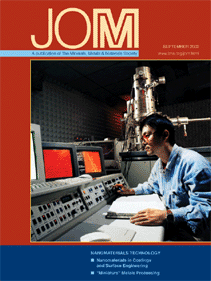VISIT THE
JOM COVER GALLERY
JOM
HOME PAGE
TABLES
OF CONTENTS
HTML-ENHANCED
ARTICLES
MATERIAL
MATTERS
CONSULTANTS
DIRECTORY
PROFESSIONAL PREFACE
SUBJECT
INDEXES
MEETINGS
CALENDAR
TECHNICAL
EMPHASIS CALENDAR
AUTHOR'S
KIT
AUTHOR
BIOGRAPHY/ABSTRACT SUBMISSION FORM
BOOK
REVIEW PROGRAM
ADVERTISING
INFORMATION
RESERVE
A CLASSIFIED
SUBSCRIPTIONS
SINGLE
ISSUE PURCHASES
LETTER
TO EDITOR
|
|
Minimizing Copyright Problems in Website Activities
Arnold B. Silverman
Websites have become an important
part of the day-to-day lives of people
throughout the world. To avoid unforeseen
copyright problems, however,
website users and website owners
should have a fundamental understanding
of certain major considerations of
copyright law.
When one creates, or has another
create a website, a threshold question
is, who will own the copyright in the
website both as originally created and
as modified periodically? If the website
is created by an employee within the
scope of his or her employment as a“work for hire,” copyright ownership
vests instantaneously in the employer.
When a third party, who is not an
employee, creates the website as a work
for hire, attention must be directed to
ownership. Perhaps the easiest way of
taking care of this issue is to have a
simple written agreement that identifies
the rights and obligations of the parties,
including the compensation of the
creator, the timing of completion and
acceptance of the website, and an
assignment of all worldwide intellectual
property rights, including, but not
limited to, copyright. In this fashion,
one does not get into what may be a
difficult issue of whether the third party
was a part-time employee and his work
was a “work for hire” and, therefore,
owned by the employer, or whether the
third party is an independent contractor
with the one hiring the contractor not
having any ownership rights in the
copyright. In the absence of an effective
transfer from the third party, the one
funding the work may end up with
merely a naked license to employ the
copyrighted material, but leave the
creator with the freedom to employ the
work for others.
A website owner must also be careful
that the content of the website does
not violate a copyright of others. The
owner of a copyright, by statute, has
the exclusive right to reproduce and
distribute the copyrighted work, make
derivative works of the same, and to
publicly perform or publicly display
certain types of work. A derivative
work is a work based upon one or more
pre-existing works, which carries over a
portion of the original work and makes
changes or additions to the work.
The Internet has raised a number
of copyright issues with respect to
what had been traditional copyright
considerations related to hard-copy
publications. For example, in a relatively
recent decision, the U.S. Supreme Court
ruled that the New York Times infringed
the copyrights of independent writers
by placing their works on the Internet,
as its agreement with the writers did not
grant them the electronic rights.
It is important, therefore, before
placing material on one’s website, to
ascertain whether the work is protected
by copyright. If it is, another question
that needs to be considered is whether
the particular use might be a “fair use.”
Fair use is a statutory limited defense
to engage in what that might otherwise
be deemed a copyright infringement.
For example, uses such as criticism,
comment, news reporting, teaching,
scholarship, or research are within
certain limitations deemed to be fair use
and not a violation of copyright. There
is no hard and fast rule for determining
whether a given proposed use is a
fair use. The statute sets forth four
tests, which are employed in making
the evaluation. The tests are: (a) the
purpose and character of the use; (b) the
nature of the copyrighted work; (c) the amount and substantiality of the portion
used in relation to the copyrighted work
as a whole; and (d) the effect of the use
upon the potential market or value of
the copyrighted work
Turning to users of websites, one
cannot assume that because the material
is on the website it is not copyrighted
or that the copyright is that of the
website owner and that an implied
license for use has been granted. The
same standards with respect to the
exclusive rights of the copyright owner
and the applicability of the fair use
doctrine need to be considered. If one
is accessing or downloading a limited
amount of material merely for the
purpose of research, and will not be
publishing the accessed material, this
tends to move the activity more toward
fair use. This again depends on an
application of all of the tests of fair
use to the particular facts. If in doubt
as to whether the proposed activity is
legal or not, one can seek consent of a
copyright owner.
In summary, it is helpful to be aware
of these potential risks and when
contemplating conduct that may subject
someone to problems with respect to
copyright ownership or infringement,
it is best to seek advice of an attorney
knowledgeable in this field.
Arnold B. Silverman is chair of the Intellectual
Property Department and a member of Eckert
Seamans Cherin & Mellott, LLC in Pittsburgh,
Pennsylvania.
For more information, contact A.B. Silverman at Eckert
Seamans Cherin & Mellott, LLC, 600 Grant Street, 44th Floor, Pittsburgh,
Pennsylvania 15219; (412) 566-2077; fax (412) 566-6099; e-mail abs@escm.com.
|

